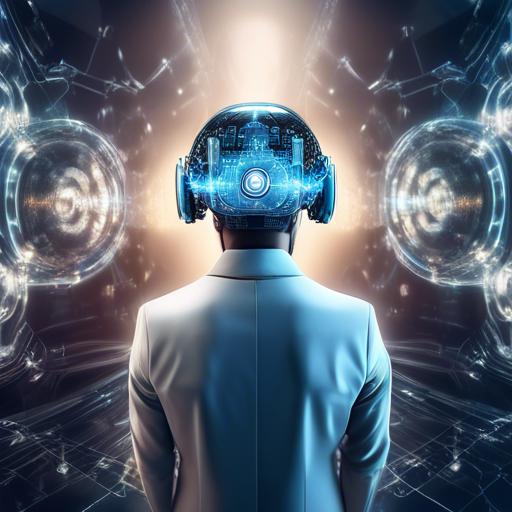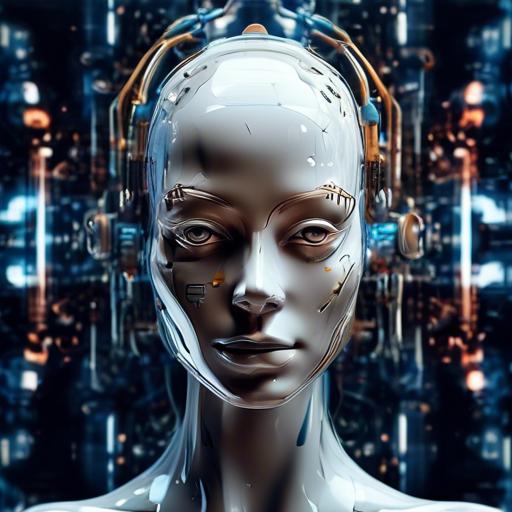Imagine stepping into a world where the boundaries between reality and imagination blur, where the fantastical becomes tangible, and where the ordinary transforms into the extraordinary. This is the promise of Virtual and Augmented Reality (VR and AR) — immersive technologies that are reshaping our perceptions and experiences. Yet, beneath the mesmerizing visuals and interactive interfaces lies a powerhouse driving these worlds to new heights: Artificial Intelligence (AI). In this journey, we’ll unravel the enchanting partnership between AI and VR/AR, exploring how intelligent algorithms are turning science fiction into our everyday reality. Prepare to dive into a realm where digital dreams come to life, guided by the unseen hand of AI, and discover how this dynamic duo is revolutionizing everything from entertainment and education to healthcare and beyond. Buckle up, because the fusion of AI with VR and AR is not just a glimpse into the future — it’s the dawn of a whole new era.
Table of Contents
- Pioneering the Future: AIs Integration with Virtual and Augmented Realities
- Enhancing Immersive Experiences: How AI Transforms User Interactions
- Behind the Scenes: AI Algorithms Driving VR/AR Innovations
- Personalized Adventures: AIs Role in Tailoring Individual VR/AR Experiences
- Breaking Boundaries: AI-Powered Solutions for Seamless Virtual Environments
- From Concept to Reality: Developing AI-Enhanced VR/AR Applications
- Ethical Considerations: Navigating AIs Impact on Virtual and Augmented Worlds
- Empowering Creators: Tools and Techniques for AI in VR/AR Development
- In Summary
Pioneering the Future: AIs Integration with Virtual and Augmented Realities
The integration of artificial intelligence into virtual and augmented reality is like weaving a magical tapestry where digital experiences become incredibly personalized and highly interactive. Imagine walking through a virtual museum where AI curates exhibits based on your personal interests, habits, and previous interactions. This level of personalization is no longer a futuristic concept but a present reality, thanks to the symbiotic relationship between AI and immersive technologies.
Artificial intelligence powers the complex algorithms that can adapt both virtual and augmented environments to meet the unique needs of individual users. **Key areas of this integration include:**
- Personalized Experiences: From gaming to education, AI tailors the content and interactions to the user’s preferences.
- Enhanced Environmental Interactivity: AI enables real-time object recognition and interaction, making virtual worlds feel more lifelike and engaging.
- Dynamic Learning and Adaptation: Systems that adjust difficulty levels or provide real-time assistance based on user performance and behavior.
Moreover, the use of AI in these realms enhances accessibility and inclusiveness. For instance, AI-driven tools can translate spoken language into text for hearing-impaired users or describe visual cues for those who are visually impaired. This transformation is making virtual and augmented realities more accessible to a broader audience, fostering a more inclusive digital landscape.
| Feature | Benefit |
|---|---|
| AI-Powered Personalization | Tailored user experiences |
| Real-time Object Interaction | Immersive and interactive environments |
| AI Translation Services | Inclusive and accessible content |
As we pioneer the future, the marriage of AI with virtual and augmented realities promises to create experiences that are not only highly personalized but also incredibly immersive and inclusive. Every user’s journey will be unique, shaped by their interactions and preferences, crafted by the intelligence of AI to ensure a dynamic and engaging adventure in the digital realm.
Enhancing Immersive Experiences: How AI Transforms User Interactions
Artificial Intelligence (AI) is redefining how we perceive and interact with digital spaces, especially in the realms of Virtual Reality (VR) and Augmented Reality (AR). By integrating AI, these platforms create more dynamic, personalized, and interactive experiences, dramatically enhancing user immersion.
One of the most profound impacts of AI is observed in **intelligent environmental adaptations**. AI algorithms can analyze user behavior to adapt the virtual environment in real-time, creating a seamless and personalized interaction. Imagine entering a virtual shopping mall where AI personalizes the store displays based on your preferences, history, and even your current mood.
The integration of AI in user interfaces allows for **natural language processing (NLP)**, facilitating intuitive voice commands and conversations. Users can interact with AI-driven avatars or virtual assistants that understand context and sentiment, providing an almost-human touch in their responses. These advanced NLP systems make VR and AR environments feel more engaging and less mechanical.
Moreover, AI-driven **predictive analytics** can track user actions and predict future behaviors, which is particularly useful in gaming scenarios. For instance, AI can adjust game difficulty levels or introduce new challenges real-time based on the player’s skill level. This ensures an optimal balance between challenge and enjoyment.
| Feature | Benefit |
|---|---|
| Intelligent Environmental Adaptations | Personalized, seamless interactions |
| Natural Language Processing | Intuitive and engaging conversations |
| Predictive Analytics | Dynamic and tailored experiences |
In addition, AI can **enhance visual realism** in VR and AR environments through machine learning techniques. AI algorithms can process complex graphics and textures, rendering realistic spaces and characters that react believably to users’ actions. This creates an immersive setting that truly blurs the lines between the virtual and real worlds.
Artificial Intelligence is no longer a mere add-on but a driving force behind richer, more engaging, and personalized VR and AR experiences. As this technology continues to evolve, the boundaries of what is possible keep expanding, offering exciting prospects for the future of immersive digital experiences.
Behind the Scenes: AI Algorithms Driving VR/AR Innovations
Virtual and Augmented Reality (VR/AR) are incredible technological advancements that are reshaping how we interact with digital spaces. At the heart of these innovations are **AI algorithms** which power everything from immersive environments to interactive user experiences. These algorithms breathe life into virtual worlds, making what was once a dream into a tangible reality.
In VR/AR, AI plays several pivotal roles:
- Object Recognition: By employing deep learning models, AI can identify and interact with real-world objects, enhancing the user’s augmented experience.
- Environment Tracking: AI algorithms help to precisely track movements within a virtual space, leading to seamless and immersive experiences in VR.
- Predictive Analytics: Predictive models enable VR systems to anticipate user actions, creating responsive and intuitive interactions.
Moreover, AI is crucial in refining **user interfaces and experiences**. Here’s how:
- Personalization: Machine learning models analyze user behavior to customize VR/AR content, resulting in a more personalized and engaging interaction.
- Adaptive Learning: AI systems learn from user interactions to make real-time adjustments, ensuring content remains relevant and engaging.
- Emotion Recognition: By analyzing facial expressions and body language, AI can adapt the VR/AR environment to reflect the user’s emotions.
AI algorithms are also pivotal for optimizing **performance and efficiency** in VR/AR applications. Here’s a comparison table highlighting AI’s efficiency improvements:
| Aspect | Before AI | After AI |
|---|---|---|
| Object Tracking | Manual and Erratic | Automated and Precise |
| Scene Rendering | Slow and Static | Fast and Dynamic |
| User Interaction | Generic | Personalized |
| Emotion Feedback | Non-Existent | Adaptive |
Ultimately, as AI continues to evolve, its synergy with VR/AR will likely unlock fascinating new dimensions of interactive experiences. By continuously learning and adapting, AI ensures that virtual and augmented reality environments are as dynamic and responsive as the real world.
Personalized Adventures: AIs Role in Tailoring Individual VR/AR Experiences
Imagine stepping into a virtual world, where every element surrounding you whispers a tale meant only for you. This vision is becoming a reality, thanks to the advances in artificial intelligence. AI algorithms can craft environments that are not just immersive, but deeply personalized. This transformation is redefining how users experience both virtual reality (VR) and augmented reality (AR), making every adventure uniquely memorable.
Artificial intelligence in VR/AR employs sophisticated user data analysis to ensure experiences are tailored to individual preferences and behaviors. This might involve tracking a user’s interactions, understanding their environment, or even gauging their emotional responses. These insights allow AI to modify the virtual landscape in real-time, offering a level of customization that feels almost magical.
- Custom avatars reflecting user characteristics
- Dynamic storylines shaped by user choices
- Adaptive difficulty levels based on user performance
The magic doesn’t stop at customization. AI extends its reach into the realm of accessibility, offering tools that ensure everyone can embark on these digital journeys. For instance, voice recognition systems can translate spoken instructions into actions, enabling hands-free navigation. Haptics can provide tactile feedback for those who rely on touch, while AI-driven sign language interpreters can make experiences more inclusive for the hearing impaired.
| Feature | AI Integration |
|---|---|
| Storyline Customization | Adaptive narratives based on user choices |
| Personalized Avatars | Avatars mimicking user traits and preferences |
| Accessibility Options | Voice commands, haptic feedback, sign language |
AI’s role in personalized VR/AR experiences is undeniably transformative. By continuously learning from user interactions and preferences, AI crafts virtual realms that are not just seen and heard, but felt and lived. These tailor-made adventures promise to keep us engaged, enchanted, and eager for the next journey, ensuring that every venture into the virtual is a step into the extraordinary.
Breaking Boundaries: AI-Powered Solutions for Seamless Virtual Environments
In the rapidly evolving landscapes of virtual and augmented reality, artificial intelligence stands as a transformative pillar, fostering experiences that are both seamless and profoundly engaging. Through complex algorithms and deep learning techniques, AI can render environments almost indistinguishable from physical reality, effectively breaking the boundaries of our sensory perceptions.
One of the most compelling applications of AI in this realm is in the development of **adaptive scenarios**. Virtual environments powered by AI can dynamically respond to user behavior, providing custom experiences tailored to individual preferences and needs. For instance, in educational settings, AI-driven avatars can simulate realistic teacher-student interactions, altering their teaching style in real time to maximize learning efficacy.
- Dynamic Lighting: AI helps in adjusting lighting based on the time of day, weather, or even the mood required for a scene.
- Object Interaction: Advanced algorithms predict user movements and facilitate realistic interactions with virtual objects.
- Emotional AI: Virtual entities can recognize and respond to human emotions, creating a more immersive and emotionally engaging experience.
An area where AI’s potential shines is in **context-aware computing**. In augmented reality, this translates to apps and devices that not only overlay information onto the real world but do so with an acute awareness of the context. Imagine walking through a museum where your AR glasses identify and provide information about the exhibits you are looking at, all while AI tailors the information depth to your prior knowledge and interests.
| Application | AI Functionality | Benefit |
|---|---|---|
| Healthcare | Simulated surgeries | Practice without risk |
| Gaming | Real-time opponent adaptation | Enhanced challenge |
| Retail | Personalized shopping experiences | Higher customer satisfaction |
Furthermore, AI is instrumental in enhancing **user accessibility** in virtual environments. Voice recognition powered by AI allows users to navigate and interact with virtual spaces using natural language commands, making these technologies more inclusive. Eye-tracking technology, another AI innovation, enables hands-free navigation and control, opening up new possibilities for users with physical disabilities.
From Concept to Reality: Developing AI-Enhanced VR/AR Applications
Transforming abstract ideas into stunning, interactive experiences is no small feat. The intersection of **Artificial Intelligence (AI)** with **Virtual Reality (VR)** and **Augmented Reality (AR)** has propelled developers to craft applications that are not only more immersive but also more intuitive and responsive. Such innovation demands a comprehensive development process that adeptly integrates AI capabilities to elevate the end-user experience.
AI-powered data analytics is a game-changer in understanding user preferences and behaviors. By analyzing user interactions in real-time, AI can personalize the VR/AR environment to match individual user needs. Here are some ways AI can be integrated into VR/AR development:
- Personalized Experiences: AI algorithms can tailor environments and scenarios to individual user preferences.
- Speech and Gesture Recognition: Advanced AI models can understand and interpret user commands seamlessly.
- Real-Time Feedback: Adaptive learning systems adjust the difficulty and content based on user performance.
- Environment Generation: AI can dynamically create and modify virtual and augmented spaces based on user actions.
The integration of AI extends beyond just user interaction. It plays a crucial role in the backend processes, optimizing performance and streamlining development workflows. Consider the following:
| AI Function | Benefits |
|---|---|
| Data Analytics | Transforms user data into actionable insights for personalized experiences |
| Automation | Speeds up the development process through automated testing and debugging |
| Optimization | Enhances app performance by optimizing resources and reducing latency |
Moreover, the fusion of AI with VR/AR ensures that applications are not static but evolve with the user. Continuous learning mechanisms allow the software to become smarter and more efficient over time, adapting to new inputs and refining outputs. This dynamic growth ensures that the user experience remains fresh and engaging, preventing the novelty of AR/VR from wearing off too quickly.
the journey from concept to reality in developing AI-enhanced VR/AR applications is marked by continuous innovation and integration. Embracing AI not only amplifies the potential of these technologies but also ensures that the applications developed are visionary, interactive, and continuously evolving, creating a symbiotic relationship between man and machine.
Ethical Considerations: Navigating AIs Impact on Virtual and Augmented Worlds
As artificial intelligence becomes increasingly integral to virtual and augmented realities, ethical considerations have come to the forefront. Navigating these concerns requires a nuanced understanding of the myriad ways AI can influence our digital landscapes.
***Equity and Access***
- **Accessibility**: Ensuring that AI-driven virtual and augmented reality (VR/AR) platforms are accessible to various populations, including those with disabilities, is crucial. This inclusive design can bridge gaps and foster a more equitable digital society.
- **Affordability**: As AI technologies develop, keeping the cost of VR/AR experiences within reach for diverse economic groups is essential. This involves addressing the “digital divide” that can emerge as technology outpaces income growth.
***Privacy and Data Security***
- **Data Collection**: AI systems collect vast amounts of data to function effectively in VR and AR environments. It’s imperative to establish strong privacy protections to prevent misuse of personal information.
- **Consent**: Users must be fully informed about what data is being collected and how it’s used, ensuring they can give or withdraw consent freely.
| Aspect | Considerations |
|---|---|
| Representation |
|
| Transparency |
|
***Accountability and Governance***
- **Ethical AI Development**: Developers must integrate ethical guidelines from the inception of AI technologies, considering potential impacts and unintended consequences.
- **Regulatory Oversight**: Policies and regulations should evolve to address the unique challenges of AI in VR/AR, providing clear frameworks to mitigate risks and ensure fair practices.
Empowering Creators: Tools and Techniques for AI in VR/AR Development
Modern creators are equipped with an ever-expanding array of cutting-edge tools and techniques, thanks to the integration of Artificial Intelligence in VR and AR development. These innovations are not only expanding the boundaries of what is possible but also making it easier for developers to bring their visions to life.
AI-driven **tools** help creators to prototype and iterate at lightning speed. Here are some of the most transformative AI tools being used today:
- Generative Design Algorithms: These powerful tools can rapidly produce a wide variety of design options, enabling creators to experiment with different ideas and find the best solutions.
- Intelligent Animation Software: Automatically generating complex animations, AI-driven software can cut down on the time and expertise needed to create life-like movements and interactions.
- Natural Language Processing: By incorporating speech and text recognition, developers can create more intuitive and immersive user interfaces.
Alongside these powerful tools, innovative **techniques** powered by AI are also revolutionizing VR and AR environments. Below are some key techniques to consider:
- Enhanced Realism: AI algorithms can enhance textures, lighting, and environmental details to create more life-like and engaging virtual worlds.
- Procedural Content Generation: AI can generate vast and diverse environments with minimal human input, providing a rich and varied user experience.
- User Behavior Prediction: By analyzing user behavior and preferences, AI can tailor experiences to individual users, making interactions more personalized and engaging.
**Comparison of AI Tools and Techniques in VR/AR Development:**
| Tool/Technique | Application | Benefit |
|---|---|---|
| Generative Design Algorithms | Rapid design prototyping | Speeds up iteration |
| Intelligent Animation Software | Automatic animation creation | Reduces manual effort |
| Enhanced Realism | Texture and lighting enhancement | More immersive environments |
| User Behavior Prediction | Personalized experiences | Higher user engagement |
For creators working in VR/AR, embracing these AI tools and techniques offers a tremendous opportunity to push the envelope of creativity and efficiency. As AI continues to evolve, the future of virtual and augmented reality promises to be even more dynamic and accessible.
In Summary
As we continue to embrace the endless possibilities of artificial intelligence, its role in shaping the virtual and augmented reality landscape is becoming increasingly significant. The convergence of these cutting-edge technologies has the potential to revolutionize the way we interact with the digital world, opening up new realms of immersive experiences and pushing the boundaries of human creativity.
From enhancing educational tools to transforming entertainment experiences, AI is truly at the forefront of pioneering innovation in virtual and augmented reality. As we look towards the future, let us continue to explore and harness the power of AI to push the boundaries of what is possible in these exciting and rapidly evolving fields.
So, embrace the potential, dive into the world of AI in virtual and augmented reality, and discover the endless opportunities that await. The journey is just beginning, and the possibilities are truly limitless. Let’s shape the future together, one exciting innovation at a time.
































